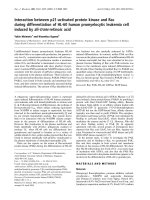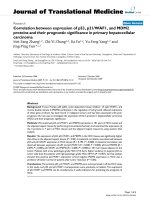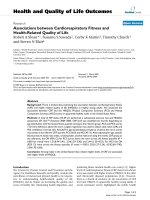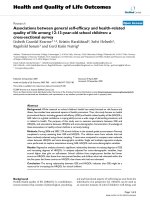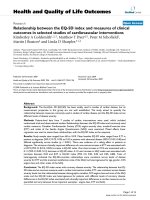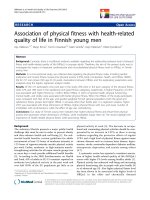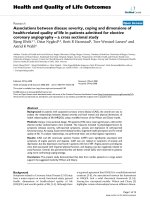báo cáo hóa học:" Association between treated/untreated traumatic dental injuries and impact on quality of life of Brazilian schoolchildren" pot
Bạn đang xem bản rút gọn của tài liệu. Xem và tải ngay bản đầy đủ của tài liệu tại đây (214.1 KB, 8 trang )
RESEARC H Open Access
Association between treated/untreated traumatic
dental injuries and impact on quality of life of
Brazilian schoolchildren
Cristiane B Bendo
1
, Saul M Paiva
1*
, Cíntia S Torres
1
, Ana C Oliveira
2
, Daniela Goursand
1
, Isabela A Pordeus
1
,
Miriam P Vale
1
Abstract
Background: Traumatic dental injury (TDI) could have physical and psychosocial consequences for children. Thus,
it is important to measure the impact of TDI on the quality of life of children (QoL). The aim of the present study
was to investigate the association between treated/untreated TDI and the impact on the quality of life of 11-to-14-
year-old Brazilian schoolchildren.
Methods: A cross-sectional study was carried out involving 1612 male and female schoolchildren aged 11 to 14
years attending public and private elementary schools in the city of Belo Horizonte, Brazil. A multi-stage sampling
technique was adopted to select the children. Three calibrated examiners used the Andreasen classification for the
diagnosis of TDI. Oral health-related quality of life was assessed using the Brazilian version of the Child Perceptions
Questionnaire (CPQ
11-14
) - Impact Short Form (ISF:16), composed of 16 items and self-administered by all children.
Other oral conditions (dental caries and malocclusion) and the Social Vulnerability Index were determined and
used as controlling variables.
Results: Two hundred nineteen children were diagnosed with untreated TDI and 64 were diagnosed with treated
TDI. There were no statistically significant associations between untreated or treated TDI and overall CPQ
11-14
(Fisher = 0.368 and Fisher = 0.610, respectively). Children with an untreated TDI were 1.4-fold (95% CI = 1.1-2.1)
more likely to report impact on the item “avoided smiling/laughing” than those without TDI, whereas children with
a treated TDI were twofold (95% CI = 1.1-3.5 ) more likely to report impact on the item “other children asked
questions” than those without TDI.
Conclusions: Neither treated nor untreated TDI was associated with oral symptoms, functional limitations or
emotional wellbeing. However, children with a TDI in the anterior teeth experienced a negative impact on social
wellbeing, mainly with regard to avoiding smiling or laughing and being concerned about what other people may
think or say.
Background
The assessment of quality of life (QoL) has become an
integral part of evaluating health programs. Traditional
dental indicators alone (with no information on oral
wellbeing) are insufficient. It is therefore important to
measure the physical and psychosocial impact of oral
health [1]. However, relationships between biological or
clinical variables and health-related quality of life are
mediated by a variety of personal, social, environmental
and cultural circumstances [1,2].
Previous studies have found that traumatic dental
injury (TDI) has biological, emotional and psychosocial
consequences for young people [2-4]. A Brazilian case-
control study found that children with fractured teeth
were more likely to experience an impact on quality of
life than those without injured teeth. Furthermore, chil-
dren with fractured teeth were more concerned with
aesthetics than function. The consequences of TDI
* Correspondence:
1
Department of Pediatric Dentistry and Orthodontics, Faculty of Dentistry,
Federal University of Minas Gerais, Av. Antônio Carlos 6627, Belo Horizonte,
MG, 31270-901, Brazil
Full list of author information is available at the end of the article
Bendo et al. Health and Quality of Life Outcomes 2010, 8:114
/>© 2010 Bendo et al; licensee BioMed Central Ltd. This is an Open Access article distributed under the terms of the Creative Commons
Attribution License (http://creativecomm ons.org/licenses/by/2.0), which permits unrestricted use, distribution, and reproduction in
any medium , provided the original work is properly cited.
include feeling embarrassed to smile, laugh and show
teeth, difficulty in social relationships, irrita bility and an
inability to maintain a healthy emotional state [3].
The treatment of TDI can improve the quality of life
of affected children. Untreated dental injuries are more
likely to have an impact on the quality of life of children
than restorations, whereas crown restorations appear to
contribute toward an improvement in the social aspects
of QoL [4]. However, the treatment of a crown fracture
does not eliminate the impact of TDI on the quality of
life of children, although it may reduce it [2].
Development influenc es a child’ scomprehension
regarding the relationship between health, illness and
QoL, and self-awareness is age-dependent, resulting
from continuous cognitive, emotional, social and lan-
guage development. It is therefore fundamental to use
the appropriate questionnaire to obtain information on
children’s oral health-related quality of life (OHRQoL)
[1,5]. The first OHRQoL instrument for children
between 11 and 14 years of age was the Child Percep-
tions Ques tionnaire (CPQ
11-14
) [6]. This instrume nt has
been proven valid and reliable for use on Brazilian chil-
dren [7,8].
Previous studies carried out in Brazil have investigated
the impact of TDI on the QoL of children [2,3]. The
two studies cited employed the Oral Impact on Daily
Performances (OIDP) [9], which is not an OHRQoL
measure designed specifically for children. The aim of
the present study is to provide additional evidence on
the association between treated/untreated TDI and its
impact on the quality of life of 11-to-14-year-old Brazi-
lian schoolchildren, using an OHRQoL instrument
designed exclusively for this age group.
Methods
Study area and design
A cross-sectional study was carried out involving 1612
children aged 11 to 14 years attending either public or
private elementary schools in the city of Belo Horizonte
from September 2008 to May 2009. Participants were
selected from a population of 170,289 children in the
same age g roup enrolled a t 311 public and 145 private
elementary schools [10]. Belo Horizonte is the capital of
the state of Minas Gerais (Brazil). It has approximately
two million in habitants and is geographically divided
into nine administrative districts, with considerable
social, economical and cultural disparities.
The sample size was calculated to give a standard error
of 2% or less, with a 95% confidence interval. To calculate
the sample, a 16.1% prevalence of TDI was used [11]. A
correction factor of 1.2 was used to increase the precision
and a multi-stage sampling technique was adopted rather
than random sampling [12]. Thus, the minimal sample
size to satisfy the requirements was estimated at 1558
individuals. However, this number was increased by
20.0% (n = 1870) in order to compensate for possible
refusals.
To ensure representativity, the sample was s tratified
according to administrative district and type of institu-
tion. The percentage distribution of 1 1-to-14-year-old
schoolchildren in each administrative district was calcu-
lated from information provided by the local Board of
Education. The distribution of participants was then
determined by the proportion of this po pulation in the
respect ive school systems using data from samples. The
first-stage was comprised of randomly selected public
and private elementary schools in each administrative
district of Belo Horizonte. In the second-stage, classes
were randomly chosen from the selected schools.
Measures
The research team was made up of three dentists (CBB,
DG and CST), who had participated in a training and
calibration exercise for each clinical condition. The
Andreasen classification [13] was used to record evidence
of TDI to upper and lower incisors: non-complicated
fracture (enamel and enamel-dentin fracture), compli-
cated fractur e (enamel-dentin-pulp fracture), tooth dislo-
cation (lateral luxation, intrusion and extrusion),
avulsion, tooth discoloration and re storation of fractu red
tooth. Malocclusion and/or untreated tooth decay were
identified as possible confounding variables; the diagnosis
of these conditions was made using the Dental Aesthetic
Index (DAI) [14] and Decayed, Missing and Filled Teeth
(DMFT) Index, respectively. DMFT were visually diag-
nosed based on World Health Organization (WHO)
recommendations [15]. Seventy-six children (not part of
the study population) were randomly selected for the
calibration process. Forty-four children were examined
by each dentist separately for the calculation of inter-
examiner agreement and 10 were re-examined after a
one-month interval for the calculation of intra-examiner
agreement. Kappa values ranged from 0.68 to 1.00 for
inter-examiner agreement and from 0.70 to 1.00 for
intra-examiner agreement, thereby demonstrating satis-
factory to excellent agreement on all clinical conditions.
The testing of the methods, dental examination,
administration of the questionnaires and preparation of
the examiners were carried out in a pilot study involving
76 children who did not participate in the main study.
The results of the pilot study indicated there was no
need to change the proposed methods.
Clinical oral examination
Dental examinations were carried out at school during
daytime hours. A head lamp (Petzl Zoom head lamp,
Petzl America, Clearfield, UT, USA), disposable mouth
mirror (PRISMA®, São Paulo, SP, Brazil) and periodontal
Bendo et al. Health and Quality of Life Outcomes 2010, 8:114
/>Page 2 of 8
probe (WHO-621, Trinity, Campo Mourão, PA, Brazil)
were used for dental ex amination. The dental exam was
limited to visual examination and no x-rays were used.
In a private room, the examiners were seated in front of
the child, who remained standing. The examination f or
TDI included only upper and lower incisors, whereas all
teeth were examined with regard to the other two oral
conditions. The examiners use d appropriate equipment
to protect against individual cross-infection, with all
necessary instruments and materials packed and steri-
lized in sufficient quantities for each workday.
OHRQoL
The impact on the QoL of children was measured using
the Brazilian version of the Child Perceptions Question-
naire (CPQ
11-14
) - Impact Short Form (ISF:16). The
CPQ
11-14
is part of the Child Oral Health Quality of Life
(COHQoL), which is a set of questionnaires that aim to
measure the impact of oral health abnormalities on the
QoL of children. The CPQ
11-14
-ISF:16iscomposedof
16 items distributed among four subscales: oral symp-
toms, functional limitations, emotional wellbeing and
social wellbeing. Each item addresses the frequency of
events as applied to the teeth, lips, jaws and mouth in
the previous three months. A five-point Likert scale is
used, with the following options: “Never” =0;“ Once/
twice” =1;“Sometimes” =2;“Often” =3;and“Every
day/almost every day” = 4 [6,16,17]. This instrument
was adapted cross-culturally and validated for use on
Brazilian children, exhibiting satisfactory psychometric
properties [8]. Prior to the examination, the CPQ
11-14
was self-administered by each child in the private room
without no outside influence. The 16 items on the
CPQ
11-14
- ISF:16 questionnaire were self-administered
by all children and were considered for the statistical
analysis.
Socioeconomic classification
The Social Vulnerability Index (SVI) was employed for
socioeconomic classifica tion. The SVI was developed by
the city of Belo Horizonte to determine the degree of
social exclusion. According to the theoretical framework
that supported the development of the SVI, social vul-
nerability is determined based on neighborhood infra-
structure and access to work, income, sanitation
services, healthcare services, education, legal assistance
and public transportation [18]. Thus, the SVI measures
social access and determines to what extent the popula-
tion of each region of the city is vulnerable to social
exclusion. These scores were calculated for each district
in a previous study by the city of Belo Horizonte. There
are five different classes, among which Class I comprises
families of the highest degree of social vulnerability
(worst conditions of housing, schooling, income, jobs,
legal assistance and health) and Class V is compo sed of
families with the lowest degree of social vulnerability
(best conditions). For the statistical analysis, the SVI was
grouped into two categories: Classes I and II were
grouped in the category “high social vulnerability” and
Classes III-V were grouped in the category “low social
vulnerability” [18-21].
Ethical considerations
Following authorization from the Ethics Committee of
the Federal University of Min as Gerais, permission was
granted by the administration of the schools. An invita-
tion letter was then sent to the parents of the selected
children, explaining the aim, characteristics, importance
and metho ds of the study and asking for per mission for
their child’s participation.
Statistics Analyses
Statistical analysis was performed using the Statistical
Package for the Social Sciences (SPSS for Windows,
version 15.0, SPSS Inc., Chicago, IL, USA). The impact on
OHRQoL was classified as absent (CPQ
11-14
=0)orpre-
sent (CPQ
11-14
≥ 1), based on previ ous OHRQoL studies
[2-4]. The Andreasen classification was used and the data
were dichotomized as treated or untreated TDI for the
statistical analyses. Each TDI condition was compared
to children who had not suffered TDI. Oral c onditions
(dental caries and malocclusion) and socioeconomic classi-
fication were used as independent and controlling vari-
ables. Malocclusion was dichotomized as absent (DAI
≤ 25) or present (DAI > 25). Dental caries was dichoto-
mized as free of teeth wit h untreated lesion or one or
more teeth with untreated lesion. Data analysis involved
descriptive statistics (frequency distribut ion and cross-
tabulation). The chi-square test and Fisher’ sexacttest
were used to determine statistically significant associations
between treated/untreated TDI and each item and
the overall CPQ
11-14
-ISF:16score.Multiplelogistic
regression was used in the multivariate analysis and was
performed to assess the relationship between treated/
untreated TDI and the CPQ
11-14
items, using the back-
ward logistic model and controlling for potential con-
founding variables (age, gender, socioeconomic status,
dental caries and malocclusion). The significance level was
set at 5%.
Results
One thousand six hundred twelve (1612) children were
examined (41.7% boys and 58.3% girls), representing 11-
to-14-year-old schoolchildren (53.1% 11-12 and 46.9%
13-14) in the city of Belo Horizonte, Brazil. The
response rate was 86.2%. The majority of children was
free of teeth with untreated lesions (72.0%), did not
have malocclusion (68.7%) and lived in areas of low
Bendo et al. Health and Quality of Life Outcomes 2010, 8:114
/>Page 3 of 8
social vulnerability (57.8%). A total of 1337 children
(82.9%) did not have any type of TDI. Two hundred ele-
ven (13.1%) had untreated TDI alone (163 had enamel
fractures, 40 had enamel-dentin fractures, five had com-
plicated crown fractures, one had lateral luxation and
two had avuls ion) and 56 (3.5%) had treated TDI alone.
Eight children had both treat ed and untreated TDI on
different teeth (Table 1).
To make the results easier to understand, only 10
CPQ
11-14
items were selected for Tables 2 and 3 - pain,
mouth sores, difficulty chewing, difficulty eating/drink-
ing hot/cold foods, felt irritable/frustrated, upset, con-
cerned with what others think, avoided smiling/
laughing, teased/called names, other children asked
questions. However, it is important to clarify that all 16
items were used for the statistical analysis.
There were no statistically significant differences
between children with untreated TDI and those without
TDI regarding the overall CPQ
11-14
-ISF:16(Fisher=
0.368). Children with untreated TDI were 1.2-fold (95%
CI = 0.9-1.6) more likely to feel “upset” and 1.2-fold
(95% CI = 0.9-1.7) more likely to have “avoided smiling/
laughing” than children without TDI, but these finding
did not achieve statistical significance in bivar iate analy-
sis (P > 0.05). Significant differences were found
between children with untreated TDI and those without
TDI on the item “concerned with what others think”
(P = 0.029). Children with untreated TDI reported less
of an impact from this item than those without TDI (PR
= 0.7, 95% CI = 0.5-0.9) (Table 2).
In the comparison of children with treated fractures
and those without TDI (Table 3), there was no associa-
tion to the overall CPQ
11-14
-ISF:16score(Fisher=
0.610). Dental pain and difficulty chewing were more
prevalent among children with treated teeth than those
with no TDI, but this difference did not achieve statisti-
cal significance (P > 0.05). On social wellbeing subscale,
only the i tem “other children asked questions” was sta-
tistically associated to treated teeth (PR = 1.5, 95% CI =
1.1-2.8, P = 0.027).
In the multiple logistic regression (Table 4), separate
CPQ
11-14
- ISF:16 items and overall score were adjusted
for age, gender, socioeconomic status, dental caries and
malocclusion. When considering untreated TDI, the
items “ concerned with what others think” , “avoided
smiling/laughing” and “other children asked questions”
remained in the model, but only two achieved statistical
significance. Children with untreated TDI were 1.4-fold
(95% CI = 1.1-2.1, P = 0.019) more likely to “ avoided
smiling/laughing” than children without TDI. However,
children with untreated TDI reported less of an impact
from the item “concerned with what others think” (PR =
0.6, 95% CI = 0.4-0.8, P = 0.003) than those without
TDI. For treated TDI, three items continued in the
model ("pain” , “ difficulty chewing” and “other children
asked questions”). Children with a treated TDI were
twofold (95% CI = 1.1-3.5) more likely to report an
impact regarding the item “other children asked ques-
tions” than those without TDI; this difference was statis-
tically significant (P = 0.012).
Discussion
The present cross-sectional survey found that overall
CPQ
11-14
- ISF:16 was not associated to TDI, which cor-
roborates a Canadian study on 11-to-14-year-old chil-
dren that employed the same questionnaire to measure
OHRQoL [4]. Another study involving Canadian chil-
dren found differences in the impact of TDI according
to socioeconomic status. In children from higher income
groups, there were no differences in CPQ
11-14
scores for
children with and without TDI. However, the differences
were significant for children in the lowest income group
[22]. Although the data of the present study were
adjusted for socioeconomic status, there was no associa-
tion between TDI and overall CPQ
11-14
- ISF:16.
Previous studies carried out in Brazil have found a statis-
tically significant association between OHRQoL and
children with untreated [3] and treated teeth with TDI [2],
adjusting for the same controlling variables (untreated
dental caries, malocclusion and socioeconomic status).
These studies used a different instrument to measure th e
impact of TDI on OHRQoL, the OIDP [9]. The age group
Table 1 Frequency distribution of the sample (n = 1612)
according to variables; Belo Horizonte, Brazil, 2009
Variables Frequency n (%)
Gender
Male 672 (41.7)
Female 940 (58.3)
Age (years)
11-12 856 (53.1)
13-14 756 (46.9)
Dental caries
Free of teeth with untreated lesion 1161 (72.0)
One or more teeth with untreated lesion 451 (28.0)
Malocclusion
Absent 1108 (68.7)
Present 504 (31.3)
Socioeconomic status
Low social vulnerability 931 (57.8)
High social vulnerability 681 (42.2)
TDI
Absence of fractures 1337 (82.9)
Untreated TDI 211 (13.1)
Treated TDI 56 (3.5)
Both untreated and treated TDI 8 (0.5)
Bendo et al. Health and Quality of Life Outcomes 2010, 8:114
/>Page 4 of 8
of these two studies was similar to that of the present
study, but the instrument had been designed for use on
adults. Thus, the differenc e between the findings of the
present study and these previous Brazilian studies [2,3]
may be explained by the choice of OHRQoL instrument.
TDI related to biological factors alone, regardless of
social patterns, may be largely ineffective information. It
is likely that multifaceted disorders have numerous risk
factors working together and it is important to consider
possi ble correlations with confounding variables [23,24].
Similarly, the presence of dental caries and malocclusion
could be correlated with the occurrence of TDI and
these oral conditions could have an influence over an
individual’s QoL [2,4,22]. Thus, these variables should
be considered confounding varia bles and included in the
multiple logistic regression due to their clinical-
Table 2 Frequency distribution of CPQ
11-14
among children with untreated TDI and absence of TDI (n = 1556); Belo
Horizonte, Brazil, 2009
TDI
Variables Untreated
TDI
(n = 219)
Absence
of TDI
(n = 1337)
Unadjusted
PR
(95% CI)
P value
Oral symptoms
Pain
CPQ
11-14
= 0 81 (37.0) 541 (40.5) 1 0.330
†
CPQ
11-14
≥ 1 138(63.0) 796(59.5) 1.1 (0.8-1.5)
Mouth sores
CPQ
11-14
= 0 85 (38.8) 475 (35.5) 1 0.348
†
CPQ
11-14
≥ 1 134 (61.2) 862 (64.5) 0.8 (0.6-1.1)
Functional limitations
Difficulty chewing
CPQ
11-14
= 0 128 (58.4) 772 (57.7) 1 0.844
†
CPQ
11-14
≥ 1 91 (41.6) 565(42.3) 0.9(0.7-1.3)
Difficulty eating/drinking hot/cold foods
CPQ
11-14
= 0 84 (38.4) 455)_34.0 1 0.212
†
CPQ
11-14
≥ 1 135 (61.6) 882 (66.0) 0.8 (0.6-1.1)
Emotional wellbeing
Felt irritable/frustrated
CPQ
11-14
= 0 138 (63.0) 827 (61.9) 1 0.743
†
CPQ
11-14
≥ 1 81 (37.0) 510 (38.1) 0.9 (0.7-1.2)
Upset
CPQ
11-14
= 0 118 (53.9) 795 (59.5) 1 0.120
†
CPQ
11-14
≥ 1 101 (46.1) 542 (40.5) 1.2 (0.9-1.6)
Concerned with what others think
CPQ
11-14
= 0 107 (48.9) 548 (41.0) 1 0.029
†
CPQ
11-14
≥ 1 112 (51.1) 789 (59.0) 0.7 (0.5-0.9)
Social wellbeing
Avoided smiling/laughing
CPQ
11-14
= 0 141 (64.4) 939 (70.2) 1 0.082
†
CPQ
11-14
≥ 1 78 (35.6) 398(29.8) 1.2(0.9-1.7)
Teased/called names
CPQ
11-14
= 0 151(68.9) 913(68.3) 1 0.845
†
CPQ
11-14
≥ 1 68 (31.1) 424 (31.7) 0.9 (0.7-1.3)
Other children asked questions
CPQ
11-14
= 0 125 (57.1) 832 (62.2) 1 0.146
†
CPQ
11-14
≥ 1 94 (42.9) 505 (37.8) 1.2 (0.9-1.6)
Overall CPQ
11-14
CPQ
11-14
= 0 5 (2.3) 19 (1.4) 0.6 (0.2-1.6) 0.368
‡
CPQ
11-14
≥ 1 214 (97.7) 1318 (98.6)
†
Chi-square test,
‡
Fisher’s exact test.
Bendo et al. Health and Quality of Life Outcomes 2010, 8:114
/>Page 5 of 8
epidemiological significance, regardless of their statistical
significance.
The association between treated/untreated TDI and
impact on QoL in the present study was stronger with
regard to social wellbeing than oral symptoms, func-
tional limitations, and emotional wellbeing. Similar
results were found in a Canadian study, w hich demon-
strated the children with untreated dental injuries
experienced a greater social impact on daily living than
those without injuries [4].
The children in the present study diagnosed with
untreated TDI felt greater dissatisfaction with their
appearance than those without TDI, especially with
regard to smiling and laughing. Children with untreated
TDI were 1.4-fold more likely to avoid smiling or laugh-
ing than children without TDI. Restor ations were found
not to eliminate the i mpact of TDI on QoL, especially
Table 3 Frequency distribution of CPQ
11-14
among children with treated TDI and absence of TDI (n = 1401); Belo
Horizonte, Brazil, 2009
TDI
Variables Treated
TDI
(n = 64)
Absence
of TDI
(n = 1337)
Unadjusted
PR
(95% CI)
P value
Oral symptoms
Pain
CPQ
11-14
= 0 20 (31.2) 541 (40.5) 1 0.142
†
CPQ
11-14
≥ 1 44 (68.8) 796 (59.5) 1.4 (0.8-2.5)
Mouth sores
CPQ
11-14
= 0 23 (35.9) 475 (35.5) 1 0.947
†
CPQ
11-14
≥ 1 41 (64.1) 862 (64.5) 0.9 (0.5-1.6)
Functional limitations
Difficulty chewing
CPQ
11-14
= 0 32 (50.0) 772 (57.7) 1 0.221
†
CPQ
11-14
≥ 1 32 (50.0) 565 (42.3) 1.3 (0.8-2.2)
Difficulty eating/drinking hot/cold foods
CPQ
11-14
= 0 25 (39.1) 455 (34.0) 1 0.407
†
CPQ
11-14
≥ 1 39 (60.9) 882 (66.0) 0.8 (0.4-1.3)
Emotional wellbeing
Felt irritable/frustrated
CPQ
11-14
= 0 43 (67.2) 827 (61.9) 1 0.390
†
CPQ
11-14
≥ 1 21 (32.8) 510 (38.1) 0.7 (0.4-1.3)
Upset
CPQ
11-14
= 0 41 (64.1) 795 (59.5) 1 0.464
†
CPQ
11-14
≥ 1 23 (35.9) 542 (40.5) 0.8 (0.4-1.3)
Concerned with what others think
CPQ
11-14
= 0 28 (43.8) 548 (41.0) 1 0.661
†
CPQ
11-14
≥ 1 36 (56.2) 789 (59.0) 0.8 (0.5-1.4)
Social wellbeing
Avoided smiling/laughing
CPQ
11-14
= 0 45 (70.3) 939 (70.2) 1 0.989
†
CPQ
11-14
≥ 1 19 (29.7) 398 (29.8) 0.9 (0.5-1.7)
Teased/called names
CPQ
11-14
= 0 48 (75.0) 913 (68.3) 1 0.258
†
CPQ
11-14
≥ 1 16 25.0) 424(31.7) 0.7(0.4-1.2)
Other children asked questions
CPQ
11-14
= 0 31 48.4) 832(62.2) 1 0.027
†
CPQ
11-14
≥ 1 33 (51.6) 505 (37.8) 1.5 (1.1-2.8)
Overall CPQ
11-14
CPQ
11-14
= 0 1 (1.6) 19 (1.4) 1 0.610
‡
CPQ
11-14
≥ 1 63 (98.4) 1318 (98.6) 0.9 (0.1-6.8)
†
Chi-square test,
‡
Fisher’s exact test.
Bendo et al. Health and Quality of Life Outcomes 2010, 8:114
/>Page 6 of 8
with regard to social wellbeing. However, children with
restored anterior teeth worried about what the other
people may think and ask about their teeth, lips, jaws or
mouth. In a Canadian study, the restoration of TDI was
found to reduce the impact on social wellbeing [4]. This
difference between studies may be explained by the aes-
thetic conditions of the restorations. In a developing
country such as Brazil, access to p ublic health care ser-
vices is limited and it is difficult to maintain restora-
tions, which is indispensable to aesthetics.
The present study demonstrates that the main con-
cerns of these children involve social interactions and
are related to the perception of others regarding their
dental appearance. At 11 to 14 years of age, relation-
shipsbetweenpeersareimportantcomponentsofan
individual’s perceptions regarding health and quality of
life. Thus, judgments on the part of peer groups can
affect an individual’s emotional state and relationships
with others [25]. Dental-facial aesthetics plays an impor-
tant role in social interaction and psychological well-
being among adolescents [26]. Health and quality of life
experienced by an individual are not determined only by
thenatureandseverityofthedisease/disorder.The
social environment, relationships and pertaining to a
group of friends are important factors in early adoles-
cence. At this age, any alteration in dental aspects can
have a negative impact on QoL [25,27].
In general, TDI was weakly associated to the OHR-
QoL of children. Although the majority of the items on
the CPQ
11-14
- ISF:16 did not have statistically signifi-
cant associations with treated/untreated TDI in the
bivariate and multivariate analyses, three items did
achieve statistically significant associations. However,
one of these items revealed that children with untreated
TDI were less likely to be concerned with what others
think about their teeth, lips, jaws or mouth than those
without TDI. Perhaps children without TDI tend to be
more careful with their teeth and suffer less TDI due to
their conc ern for what others think. On the other hand,
this result could be a sign an ineffective instrument for
measuring the impact of TDI on the OHRQoL of chil-
dren, as it is not a condition-specific instrument.
Since the CPQ
11-14
- ISF:16 is a generic measure and
was not specifically designed for TDI, the lack of an
association between TDI and overall CPQ
11-14
as well as
themajorityofindividualitems may reflect this limita-
tion. Some items may not necessarily be relevant to chil-
dren with TDI. Thus, it is possible that the CPQ
11-14
-
ISF:16 was unable to discriminate between children with
and without TDI accordingly. It may therefore be time
to develop o f a TDI-specific OHRQoL instrument and
further studies in this direction should be encouraged.
We recognize that the impact observed on OHRQoL
could be from other oral conditions. In order to
Table 4 Multiple logistic regression models explaining the influence of TDI on each item of CPQ
11-14
; Belo Horizonte,
Brazil, 2009
Variables Unadjusted PR (95% CI) Adjusted PR (95% CI)
§
P value
Untreated TDI
Concerned with what others think
CPQ
11-14
= 0 1 1 0.003
CPQ
11-14
≥ 1 0.7(0.5-0.9) 0.6 (0.4-0.8)
Avoided smiling/laughing
CPQ
11-14
= 0 1 1 0.019
CPQ
11-14
≥ 1 1.2 (0.9-1.7) 1.4 (1.1-2.1)
Other children asked questions
CPQ
11-14
=0 1 1
CPQ
11-14
≥ 1 1.2 (0.9-1.6) 1.2 (0.9-1.7) 0.111
Treated TDI
Pain
CPQ
11-14
= 0 1 1 0.214
CPQ
11-14
≥ 1 1.4 (0.8-2.5) 1.4 (0.8-2.6)
Difficulty chewing
CPQ
11-14
= 0 1 1 0.172
CPQ
11-14
≥ 1 1.3 (0.8-2.2) 1.4 (0.8-2.5)
Other children asked questions
CPQ
11-14
= 0 1 1 0.012
CPQ
11-14
≥ 1 1.6 (1.1-2.8) 2.0 (1.1-3.5)
PR: Prevalence ratio.
CI 95%: Confidence interval.
§
Adjusted for control variables (age, gender, socioeconomic status, dental caries and malocclusion).
Bendo et al. Health and Quality of Life Outcomes 2010, 8:114
/>Page 7 of 8
minimize this bias, w e controlled the data for potential
confounding variables, such as untreated dental caries
and malocclusion.
Conclusions
Neither treated nor untreated TDI was associated to
oral symptoms, functional limitations or emotional well-
being. However, children with these oral conditions in
the anterior teeth were more likely to experience a
negative impact on social wellbeing, especially with
regard to avoiding smiling or laughing and beings con-
cerned about what other people may think or say. This
information is clinically relevant and making these
results public may therefore be useful.
Abbreviations
TDI: Traumatic dental injury; QoL: Quality of life; OHRQoL: Oral health-related
quality of life; CPQ
11-14
: Child Perceptions Questionnaire; ISF:16: Impact Short
Form; SVI: Social Vulnerability Index; DAI: Dental Aesthetic Index; DMFT:
Decayed, Missing and Filled Teeth; COHQoL: Child Oral Health Quality of
Life; OIDP: Oral Impact on Daily Performances.
Acknowledgements
This study received support from the National Council for Scientific and
Technological Development (CNPq), Ministry of Science and Technology and
the State of Minas Gerais Research Foundation (FAPEMIG), Brazil.
Author details
1
Department of Pediatric Dentistry and Orthodontics, Faculty of Dentistry,
Federal University of Minas Gerais, Av. Antônio Carlos 6627, Belo Horizonte,
MG, 31270-901, Brazil.
2
Department of Social and Preventive Dentistry,
Faculty of Dentistry, Federal University of Minas Gerais, Av. Antônio Carlos
6627, Belo Horizonte, MG, 31270-901, Brazil.
Authors’ contributions
CB, SP, CT, DG, IP and MV conceptualized the rationale and designed the
study. CB, SP, CT, AO, DG and MV performed the data collection, statistical
analysis and interpretation of the data. CB, SP, CT and DG conducted the
literature review and drafted the manuscript. All authors read and approved
the final manuscript.
Competing interests
The authors declare that they have no competing interests.
Received: 30 March 2010 Accepted: 4 October 2010
Published: 4 October 2010
References
1. Barbosa TS, Gavião MB: Oral health-related quality of life in children: Part
II. Effects of clinical oral health status. A systematic review. Int J Dent Hyg
2008, 6:100-107.
2. Ramos-Jorge ML, Bosco VL, Peres MA, Nunes AC: The impact of treatment
of dental trauma on the quality of life of adolescents: a case-control
study in southern Brazil. Dent Traumatol 2007, 23:114-119.
3. Cortes MI, Marcenes W, Sheiham A: Impact of traumatic injuries to the
permanent teeth on the oral health-related quality of life in 12-14-year-
old children. Community Dent Oral Epidemiol 2002, 30:193-198.
4. Fakhruddin KS, Lawrence HP, Kenny DJ, Locker D: Impact of treated and
untreated dental injuries on the quality of life of Ontario schoolchildren.
Dent Traumatol 2008, 24:309-313.
5. Barbosa TS, Gavião MB: Oral health related quality of life in children: Part
I. How well do children know themselves? A systematic review. Int J
Dent Hyg 2008, 6:93-99.
6. Jokovic A, Locker D, Stephens M, Kenny D, Tompson B, Guyatt G: Validity
and reliability of a questionnaire for measuring child oral-health-related
quality of life. J Dent Res 2002, 81:459-463.
7. Goursand D, Paiva SM, Zarzar PM, Ramos-Jorge ML, Cornacchia GM,
Pordeus IA, et al: Cross-cultural adaptation of the Child Perceptions
Questionnaire 11-14 (CPQ11-14) for the Brazilian Portuguese language.
Health Qual Life Outcomes 2008, 6:2.
8. Torres CS, Paiva SM, Vale MP, Pordeus IA, Ramos-Jorge ML, Oliveira AC,
et al: Psychometric properties of the Brazilian version of the Child
Perceptions Questionnaire (CPQ
11-14
)-short forms. Health Qual Life
Outcomes 2009, 7:43.
9. Adulyanon S, Vourapukjaru J, Sheiham A: Oral impacts affecting daily
performance in a low dental disease Thai population. Community Dent
Oral Epidemiol 1996, 24:385-389.
10. Belo Horizonte City Hall - Census data of school 2007. [.
gov.br], Accessed on May 27, 2009 [in Portuguese].
11. Cortes MI, Marcenes W, Sheiham A: Prevalence and correlates of
traumatic injuries to the permanent teeth of schoolchildren aged 9-14
years in Belo Horizonte, Brazil. Dent Traumatol 2001, 17:22-26.
12. Kirkwood BR, Stern J: Essentials of Medical Statistics London: Blackwell 2003.
13. Andreasen JO, Andreasen FM, Andersson L: Textbook and color atlas of
traumatic injuries to the teeth Copenhagen: Munskgaard, 4 2007.
14. Cons NC, Jenny J, Kohout FJ: DAI: the dental aesthetic index Iowa City, Iowa:
College of Dentistry, University of Iowa 1986.
15. World Health Organization: Oral health surveys. Basic methods Geneva:
World Health Organization, 4 1997.
16. Jokovic A, Locker D, Tompson B, Guyatt G: Questionnaire for measuring
oral health-related quality of life in eight-to-ten-year-old children. Pediatr
Dent 2004, 26:512-518.
17. Jokovic A, Locker D, Guyatt G: Short forms of Child Perceptions
Questionnaire for 11-14-year-old children (CPQ
11-14
): development and
initial evaluation. Health Qual Life Outcomes 2006, 4:4.
18. Nahas MI, Ribeiro C, Esteves O, Moscovitch S, Martins VL: O mapa da
exclusão social de Belo Horizonte: metodologia de construção de um
instrumento de gestão urbana. Cad Cienc Soc 2000, 7:75-88, [in
Portuguese].
19. Bonanato K, Paiva SM, Pordeus IA, Ramos-Jorge ML, Barbabela D, Allison PJ:
Relationship between mothers’ Sense of Coherence and oral health
status of preschool children. Caries Res 2009, 43:103-109.
20. Serra-Negra JM, Ramos-Jorge ML, Flores-Mendoza CE, Paiva SM, Pordeus IA:
Influence of psychosocial factors on the development of sleep bruxism
among children. Int J Paediatr Dent 2009, 19:309-317.
21. Viegas CM, Scarpelli AC, Carvalho AC, Ferreira FM, Pordeus IA, Paiva SM:
Predisposing factors for traumatic dental injuries in Brazilian preschool
children. Eur J Paediatr Dent 2010, 11:59-65.
22. Locker D: Disparities in oral health-related quality of life in a population
of Canadian children. Community Dent Oral Epidemiol 2007, 35:348-356.
23. Newton JT, Bower EJ: The social determinants of oral health: new
approaches to conceptualizing and researching complex causal
networks. Community Dent Oral Epidemiol 2005, 33:25-34.
24. Kraemer HC: Epidemiological methods: about time. Int J Environ Res Public
Health 2010, 7:29-45.
25. Jokovic A, Locker D, Guyatt G: What do children’s global ratings of oral
health and well-being measure? Community Dent Oral Epidemiol 2005,
33:205-211.
26. Marques LS, Ramos-Jorge ML, Paiva SM, Pordeus IA: Malocclusion: esthetic
impact and quality of life among Brazilian schoolchildren. Am J Orthod
Dentofacial Orthop 2006, 129:424-427.
27. Bee H: Lifespan development New York: Addison Wesley Longman, 2 1998.
doi:10.1186/1477-7525-8-114
Cite this article as: Bendo et al.: Association between treated/untreated
traumatic dental injuries and impact on quality of life of Brazilian
schoolchildren. Health and Quality of Life Outcomes 2010 8:114.
Bendo et al. Health and Quality of Life Outcomes 2010, 8:114
/>Page 8 of 8
